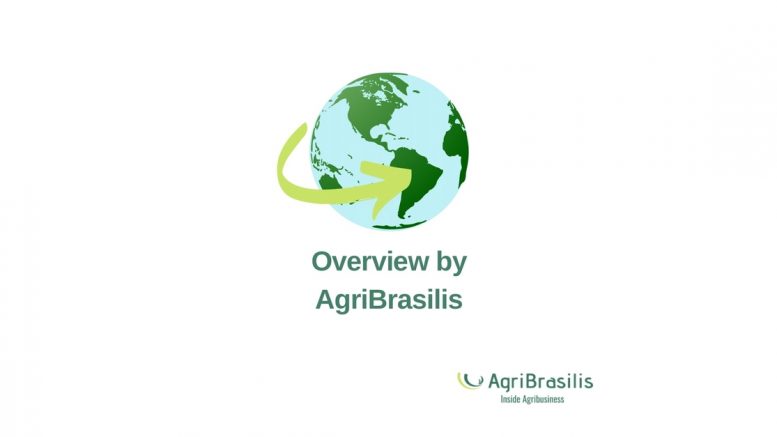Agricultural Sector Lost US$ 1.2 Billion in Chile
Control of ticks in cattle results in a 400 g/day extra weight gain, according to a study performed in Chaco and Corrientes, where researchers followed three groups of cattle for 10 months, with only two groups treated against ticks. (National Institute of Agricultural Technology)
Ended corn harvest, with total production 3 million tonnes lower than in the previous harvest, reaching 52 million tonnes. National yield average was 116.5 bags per hectare. (Buenos Aires Cereal Exchange)
Alert for greater presence of pests. Winter with little frost and higher average temperatures can cause an increase in the population of insects in the Central Region, mainly of the pest Nysius simulans, and of the potato-bug, Armadillidium vulgare. (National Institute of Agricultural Technology)
Imports of nitrogen fertilizers have recorded a sharp drop of 42% since the beginning of the year. Smaller planted area for wheat cultivation and unfavorable purchase ratios are the reasons given for the decrease. (AZ Group)
![]()
Ministry of Agriculture inspects 15 points of sale of organic products and two OCSs – groups of farmers that carry out their own verification and control of the commercialization of organic products – in five cities in the interior of the State of São Paulo. Inspection resulted in seven infraction notices. (MAPA)
Brazilian Development Bank (main financing agent for development in Brazil) has no more resources for Moderfrota, a financing program for agricultural machinery, according to the president of the Sectorial Chamber of Agricultural Machinery and Implements at Abimaq, Pedro Estevão. (Brazilian Association of Machinery and Equipment Industry)
Soybean and corn high production costs affect the competitiveness in the international market. Brazil has the highest costs among the main soybean growing countries, considering the average of the last five years, being almost double of the costs from Argentina and 12% higher than from the USA. (Cepea)
Cocoa Pest Identification System will facilitate diagnosis of diseases and pests. Farmers will be able to forward audios, images and videos of cocoa farms or fruits to researchers from the Executive Committee of the Cocoa Farming Plan, who will perfom out analyses, inspections and technical assistance. (MAPA; Ceplac)
A 54.8% orange juice inventory drop was recorded in June 30, compared to the same period in 2021. For the 2022/23 season, it is estimated a total of 140 thousand tonnes. According to the executive director of CitrusBR, Ibiapaba Netto, inventory reduction was expected dua to a decrease in processing. (CitrusBR)
High production costs force pig farmers to give up the activity in the State of Santa Catarina. Price paid per kg rose from US$ 0.85 to US$ 1.29 in the last quarter, but it is still considered insufficient to cover the expenses of the activity. (Swine Breeders Association of Santa Catarina)

![]()
Agricultural sector lost US$ 1.2 billion due to high costs and problems during exportation in the last harvest. Jorge Valenzuela, president of Fedefruta, claims that a high dollar does not compensate for the increase in production costs for the sector. (National Society of Agriculture; Fedefruta)
INIA announces construction of a new Regional Center for the Norte Grande region, where 40% of the country’s vegetables are produced. (National Institute for Agricultural Research)
![]()
World Bank might grant credit of US$ 50 million to reduce costs of agricultural inputs. An emergency loan proposal is still under negotiation, led by the Minister of Agriculture, Cecília López Montaño. The proposal for granting credit has already been approved by the Ministry of Finance. (Ministry of Agriculture)
Center for Research and Advanced Studies completes analysis of the genomes of agave, blackberry, vanilla, papaya and lemon. The objective is to generate tools that could establish genetic improvement programs for those crops. (Secretary of Agriculture)
Tamaulipas region presents drought in 99.5% of its territory. Dams have low levels of water storage, reaching one third of capacity in some cases. Central and Northern regions of Tamaulipas are the most affected by the lack of regular rains, which has been occurring for the last four years. (National Water Commission)

![]()
Study demonstrates that agriculture does not pollute the water bodies of Arroyo Capiibary. Samples from almost 100 wells and underground streams were sent to a laboratory in Germany, which revealed that there is no contamination in Itapuá and Alto Paraná. This is considered a consequence of no-till. (Ministry of the Environment)
![]()
Cotton production is growing again due to good international prices. After only one season, prices doubled as a result of international demand. It is estimated that the planted area will grow from 5,700 to 20,000 hectares for the next harvest. (National Association of Cotton Farmers)

MORE ABOUT AGRIBUSINESS:

